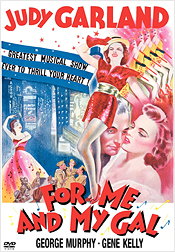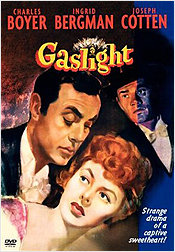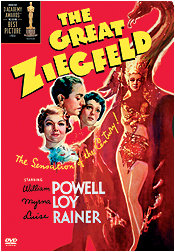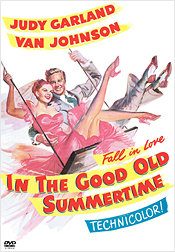 |
Site created 12/15/97.

page created: 4/12/04
 Barrie Maxwell - Main Page |
| Classic
Reviews Round-Up #2 - March 2004 It's pretty common knowledge that Warner Bros. has an impressive line-up of classic releases planned for 2004. April will see a focus on Judy Garland; May is Marx Brothers month; June will see collections for Cary Grant and Tarzan; and July will feature Elvis. For now, however, I'm mainly going to catch up on Warners' offerings in February and March with reviews of Gaslight, The Great Ziegfeld, Mutiny on the Bounty, the Chaplin Collection Volume 2, and The Prisoner of Second Avenue. However, I also dip into early April with reviews of For Me and My Gal, In the Good Old Summertime, and Meet Me in St. Louis. The reviews are organized alphabetically by film title. You'll see the word "recommended" a lot here. The Chaplin Collection, Volume 2 (various release years) (released on DVD by Warner Bros. on March 2nd, 2004) Along with The Chaplin Collection, Volume 1, this second DVD collection produced by the French company MK2 in conjunction with the Charlie Chaplin estate and released in Region 1 courtesy of Warner Bros. provides a virtually definitive packaging of all of Chaplin's major films. Were it not for an unfortunate lapse in authoring for the North American market, I suspect these box sets would have universal approval. Despite that, the results are impressive indeed with generally sparkling transfers and admirably thorough supplements. |
| City
Lights is the highlight of this set - an appealing blend
of comedy, sentimentality, and romance as the Tramp befriends a
blind girl who needs money both to keep the home where she lives
with her grandmother as well as to pay for an eye operation to cure
her blindness. Made in 1931 when Chaplin was not yet ready to
embrace sound, the film is easily on a par with The
Gold Rush and Modern Times
- Chaplin's other masterpieces. The bittersweet love story takes
centre stage here and is punctuated by only enough comedy (the
spaghetti eating sequence and the boxing match, for example) to
provide a proper balance. The ending is appropriately ambivalent.
Presented on DVD in a two-disc edition, the film is supported by a
wealth of supplements, most notably an introduction by Chaplin
biographer David Robinson providing some context for the film and a
documentary (Chaplin Today: City Lights)
featuring animation artist and director Peter Lord that provides
some modern perspectives. Other extras include outtakes and a screen
test, an excerpt from 1915's The Champion
(an early Chaplin staging of a boxing match), a rehearsal of a
complicated scene, a visit by Winston Churchill to the City
Lights set, footage of a visit by Charlie and Sydney
Chaplin to Bali in 1932, photo and poster galleries, and trailers. The Circus (1928) sometimes gets lost among the Chaplin oeuvre and that's a shame because it contains some of his funniest work. Here the emphasis is on making us laugh, not overly accompanied by sentimental sub-plots. The film's success was acknowledged at the first Academy Awards ceremony in May 1929, as The Circus brought Chaplin a special Oscar "for versatility and genius in writing, acting, directing, and producing...". Just by hearing the title, one can almost visualize the sort of antics that the Tramp gets into. They turn out to be such things as a crazy fun-house sequence, a tightrope walk complicated by monkeys, and a magic skit that goes completely awry. The two-disc DVD presentation contains the usual David Robinson introduction and Chaplin Today documentary (this time featuring director Emir Kusturica). Other extras include a deleted sequence, extensive outtakes, home movies of Chaplin from the Lord Louis Mountbatten archive, a newsreel about the Los Angeles premiere, an excerpt from Circus Day starring Jackie Coogan, poster and stills galleries, and trailers. The Kid (1921) was the first feature-length film that Chaplin wrote and directed and it proved to be a tremendous success with both the critics and the public. The story has the Tramp finding a baby abandoned by his mother and deciding to rear it himself. As the kid grows up, he and the Tramp make a great pair of con artists. (The kid breaks windows and then Charlie appears offering to repair the damage.) A fight that the kid gets into leads to a chain of events that involves the return of the kid's mother and the resulting efforts by both her and Charlie to assume or retain custody of the kid. The film has its share of gags, but also offers the blend of comedy and sadness that would become typical of Chaplin's work. Of particular note is the excellent work as the kid by Jackie Coogan - at six years of age, seemingly as accomplished an actor as those much older and with years of experience. The two-disc DVD presentation contains the following supplements: introduction by David Robinson, Chaplin Today: The Kid (a new documentary on the film featuring Iranian filmmaker Abbas Kiarostomi), three scenes deleted from the film by Chaplin when it was reissued in 1971, a How to Make Movies featurette in which Chaplin shows the building of his new studio and how films are made there, a later feature film starring Jackie Coogan and entitled My Boy, a home movie of the Mountbattens with Chaplin and Coogan, newsreel footage, posters and a photo gallery, and trailers. The Chaplin Revue is a two-disc set that contains seven Chaplin shorts made for First National during the period 1918 to 1923. The first disc contains three of these (A Dog's Life, Shoulder Arms, The Pilgrim) that were later put together by Chaplin in 1959 in a feature he called The Chaplin Revue. The other four (A Day's Pleasure, Sunnyside, The Idle Class, Pay Day) appear separately on the second disc. (Note that the DVD packaging mixes up which shorts are on which disc and is not thorough in listing their original release years.) All of these shorts represent Chaplin at his peak and it is impossible for me to say which one I like best. Each has its moments and you can dip into them at any point and come away instantly entertained. The supplementary material is spread over both discs, and includes introductions by David Robinson, deleted scenes from Sunnyside and Shoulder Arms, footage for an uncompleted short with Chaplin and British music hall comedian Harry Lauder, a World War I propaganda film featuring Chaplin (The Bond), a repeat of the How to Make Movies featurette, posters and photo galleries, and The Chaplin Revue trailer. Another two-disc set contains A Woman of Paris (1923) on one disc and A King in New York (1957) on the other. I've never had much time for the latter (wherein a European king becomes the darling of the U.S. media), for it strikes me as a self-indulgent and overly-extended exercise in its satirizing of the worst of 1950s American society. Not that there's anything wrong with the film's premise, it's all just too blandly handled to be really effective. Occasional insertions of Chaplinesque comedy bits seem more tired than anything else. On the other hand, A Woman of Paris shows that Chaplin had a sure hand for drama. Telling a story of a small-town girl who mistakenly leaves her sweetheart to go to Paris where she eventually becomes the mistress of a wealthy playboy, the film was Chaplin's first one for United Artists - the company formed by Chaplin, Douglas Fairbanks, Mary Pickford, and D.W. Griffith in 1919. Despite Chaplin's sensitive, non-judgmental handling of the film's plot and reasonable critical approval, A Woman of Paris was not the sort of picture filmgoers expected from Chaplin and so was a box office failure. Don't allow that original reaction to prevent you from enjoying this sensitive tale with an appealing performance by Edna Purviance in the title role and good work by Adolph Menjou as the wealthy Parisian. Chaplin has a brief cameo as a railway porter. The DVD supplements include introductions by David Robinson, the usual Chaplin Today documentaries, scenes deleted for the films' later reissues, footage of the contract signing that created United Artists, an amateur movie called Camille that features many New York personalities (made by Ralph Barton in 1926), images of Paris in the Roaring Twenties, posters and photo galleries, and trailers. Monsieur Verdoux (1947) is what Chaplin referred to as a "comedy of murders", essentially the tale of a Paris bluebeard who murders his wives for their money. The film awkwardly blends drama with black comedy so that one is never sure whether to laugh or cry. Chaplin does create in interesting character in his portrayal as Verdoux and there's some good supporting work by Martha Raye and Isobel Elsom, but it all goes on too long so that eventually, you don't really care which way you react. Chaplin had originally intended for Edna Purviance to play a major role, but she was not interested in a comeback and in the end only appeared in the film as an extra. Warners devotes only a single disc to the film and includes as extras the usual David Robinson introduction, the documentary Chaplin Today: Monsieur Verdoux (featuring director Claude Chabrol), plan drawings for the set and preparatory sketches, a photo gallery, film posters, and trailers. The final disc in the set is devoted to a 2003 documentary on Chaplin (Charlie: The Life and Art of Charles Chaplin) prepared by Richard Schickel and narrated by Sydney Pollack. It contains ample clips from Chaplin's films, footage of contemporary events, samples of home movies, and interviews with Chaplin Family members as well as the likes of Martin Scorsese, Woody Allen, Robert Downey Jr., and Johnny Depp. The film was a popular item at the 2003 Cannes Film Festival, but it must be stated that even at 133 minutes in length, the film is barely long enough to do justice to Chaplin's life and work, with his later years suffering somewhat in terms of coverage. Inevitably, there is also some repetition of the material available as supplements on the other discs in the set. Seen as a stand-alone piece, however, this is still an admirable effort and is a good starting point for those just delving into Chaplin for the first time. There are no supplements on this disc. These discs represent new digital transfers - all, with the exception of the new documentary, from Chaplin family vault picture and audio elements. The result is that in general, these are the best-looking presentations of the films available on DVD. There is still evidence of speckling and some debris, but the images are bright and generally crisp with decent contrast. There are some edge effects present, but it is not an issue of great concern as the occurrences are generally not significant in intensity or duration. All films are presented full frame as originally shot, even the documentary while is incorrectly labeled as being widescreen on its packaging. I must point out, however, that what Warners has provided represents NTSC products based on PAL originals, resulting in mildly blurred images whenever rapid motion occurs on the screen. For many people, this will be such a minor issue as to be inconsequential, but for others, it will be noticeable enough for them to prefer to seek out Region 2 versions, which will of course not be compromised by the issue. If this is a possible concern, I can only suggest perhaps renting one of the discs in order to judge for yourself before making a purchase decision. The discs present both the original mono tracks as well as ones remastered in Dolby Digital 5.1. The 2.0 mono tracks are generally all you need to enjoy these films. They offer decent fidelity, are generally free of hiss, and are characterized by little distortion. The new 5.1 tracks don't improve on the mono ones to any great degree. They offer a slightly more expansive front sound stage, but surround usage is minimal. A couple of the films (Monsieur Verdoux and A King in New York) provide French mono tracks which are characterized by more hiss than their English counterparts. Sub-titling is provided in English, French, Spanish, Portuguese, Chinese, Thai, and Korean. Many Chaplin enthusiasts will have already acquired the previously available Image DVD versions of these titles. The new collection is not a replacement for them, as the Image ones offered the original versions of these films rather than the edited versions created by Chaplin in later years and which are the ones in the new box set. The images on the Image discs are not as clean nor quite as sharp as the new ones, but on the other hand, they do not suffer from the PAL-NTSC blurring issue. Despite this latter concern, The Chaplin Collection, Volume 2 is highly recommended. For Me and My Gal (1942) (released on DVD by Warner Bros. on April 6th, 2004) The release of For Me and My Gal signaled two new things. One was the real beginning of more mature roles for Judy Garland (she was also billed alone above the title for the first time). Her previous film had been Babes on Broadway with Mickey Rooney, but there would be only one more such collaboration (Girl Crazy) as Garland shifted to more adult roles as in 1943's Presenting Lily Mars and later The Clock and The Harvey Girls. The second significant thing about For Me and My Gal was the film debut of Gene Kelly. Kelly had been enticed to MGM following successful work on Broadway, and it was decided that this film would provide a good opportunity for his screen appearance. Initially, George Murphy was to be the film's male lead next to Judy, but with Kelly coming aboard, Murphy slipped to the third lead. Kelly was an instant success and the brashness that characterized so much of Kelly's later work was immediately in evidence. He and Garland worked very well together, both singing and dancing, in such toe-tappers as the title song and "Ballin' the Jack". Judy also has good singing opportunities with "After You're Gone" and "Till We Meet Again". |
| Pleasing
too is Warners' fine transfer of this black and white film. The
image is presented correctly full frame and generally delivers a
nicely-detailed gray scale, framed by glossy blacks and clean
whites. There are a couple of minor hints of edge effects, but film
grain is minor and source material defects are few. The mono sound
is free of hiss and delivers quite a rich, clear tone to the musical
numbers. English, French, and Spanish sub-titles are provided.
Supplements include an informative commentary by Garland biographer
John Fricke and two vintage 1936 musical shorts. La
Fiesta de Santa Barbara is a rich-looking but bizarre
Technicolor extravaganza featuring a number of Hollywood performers
(Buster Keaton, Robert Taylor, Ida Lupino, Leo Carillo, Warner
Baxter, Gary Cooper, Ted Healy, Andy Devine, etc.) and a performance
of "La Cucaracha" by the Gumm sisters (one of whom is a
young Judy Garland). The other short, Every
Sunday, features both Garland and Deanna Durbin singing
separately and together. Other extras are photo-recreations of the
deleted finale number from the film and an outtake of "Three
Cheers for the Yanks", the 1943 Screen Guild Players radio
production of the film, a radio promo, and the theatrical trailer.
Recommended. Gaslight (1944, 1940) (released on DVD by Warner Bros. on February 3rd, 2004) The focus of this release is the 1944 MGM version of Gaslight, but included on the disc is the original 1940 British version. Both are based on the stage play, "Angel Street", by Patrick Hamilton. Set in the 19th century, the story concerns a woman whose husband is trying to make her believe she is crazy while he searches in the attic of their home for valuable jewels belonging to another woman he previously murdered. |
| With
both versions of the film (one on each side of the disc) and several
good supplements, this DVD is an attractive package. The 1944
version looks exquisite. Presented full frame in accord with its
original aspect ratio, the image conveys a very film-like quality.
Blacks are deep and glossy and whites are very clean. Source
material defects are almost non-existent and some modest grain is
evident. Edge effects are non-existent. In comparison, the 1940
version (also correctly presented full frame) is somewhat pale and
more prone to age-related defects, but still quite acceptable. The
mono sound yields only modest hiss (a little more evident on the
1940 version) so that dialogue is clear throughout. English and
French tracks (the latter only for the 1944 version) are available
as are English, French, and Spanish sub-titles. The supplements
include a good reminiscence on Ingrid Bergman's performance and the
1944 film hosted by Bergman's daughter, Pia Lindstrom. Included in
this piece (Reflections on Gaslight)
are comments by Angela Lansbury. A newsreel of a segment of the 1944
Academy Awards ceremony and a theatrical trailer for the 1944 film
round out the disc. Recommended. The Great Ziegfeld (1936) (released on DVD by Warner Bros. on February 3rd, 2004) Not to be outdone by the musical extravaganzas concocted by Busby Berkeley over at Warner Bros. or the developing public appetite for biographic films also being fed by Warners, MGM entered the fray with its lengthy and opulent tribute to the life of Broadway musical impresario Florenz Ziegfeld Jr. The project had actually begun several years earlier at Universal, but financial difficulties there resulted in an arrangement with MGM to take over production. (Part of the deal was that William Powell who had originally been loaned to Universal by MGM to star in the picture would continue in the title role, but would be loaned out to Universal later for a different film. That proved to be the delightful My Man Godfrey, made in 1936.) |
| Warners'
DVD presentation is a strong one. Despite some scratches and a few
sequences with noticeable grain and speckling, the full frame image
(as originally shot) is generally sharp, offering deep blacks and
very good shadow detail. Edge effects are non-existent. The mono
sound is quite acceptable in clarity, although there is minor hiss
evident. English, French, and Spanish sub-titles are provided. Two
short supplements complement the film very well. One is a new
featurette containing comments from Ziegfeld family members and a
very feisty 94-year-old Luise Rainer on the making-of the film,
while the other is an interesting newsreel of the film's New York
premiere with comments from the likes of Jack Oakie, Harpo Marx
('Honk, honk"), and Ed Sullivan. Recommended. In the Good Old Summertime (1949) (released on DVD by Warner Bros. on April 6th, 2004) Nikolaus Laszlo's 1936 play "Perfumerie" has served as the basis for a number of stage and screen productions over the past 65-odd years. The plot concerns two employees at a store who can't stand each other on the job, but unknowingly are in love by virtue of letters they exchange through the mail in response to a personal ad. The first film of the play was Ernst Lubitsch's The Shop Around the Corner in 1940 starring Jimmy Stewart and Margaret Sullavan, which remains the definitive screen version. Most recently, there was the insipid You've Got Mail rendering in 1998 with Tom Hanks and Meg Ryan. Between these two, MGM had the bright idea of turning the tale into a musical and tossed the idea around for four or five years before producing In the Good Old Summertime for release in 1949. Any number of cast possibilities were considered including the likes of Frank Sinatra, Mickey Rooney, Gene Kelly, Peter Lawford, June Allyson, Gloria De Haven, and Mary Astor before settling on Judy Garland and Van Johnson for the lead roles. |
| Warner Bros. gives another classic fine treatment here. The full frame (as originally shot) Technicolor image looks beautiful. Colours are clear and vibrant with accurate flesh tones and picture detail is very good. The mono sound is in excellent shape, free of hiss and even suggesting some fidelity to the music. English, French, and Spanish sub-titles are provided. Supplements include a short introduction by Garland biographer John Fricke that provides some context for the film, two James Fitzpatrick MGM Traveltalks shorts in Technicolor about Chicago (the film's setting), and theatrical trailers for this film, The Shop Around the Corner, and You've Got Mail. |
On to Part Two
Barrie Maxwell - Main Page
 |
| Site
designed for 1024 x 768 resolution, using 16M colors and .gif 89a
animation. © 1997-2015 The Digital Bits, Inc., All Rights Reserved. billhunt@thedigitalbits.com |




